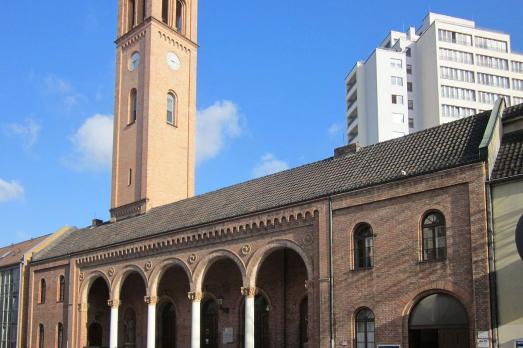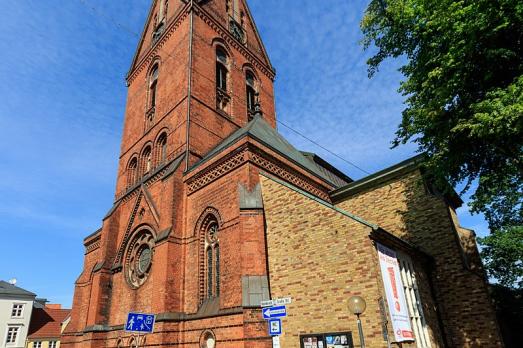St.-Antonius van Padua kerk
Nijnsel, NL
Charming little neo-Romanesque church with tower, in the hamlet of Nijnsel. This church is listed as a National Monument of the Netherlands.
Here you can search for a building to visit. You can use the map find destinations, or you can use the filters to search for a building based upon what different criteria.
Nijnsel, NL
Charming little neo-Romanesque church with tower, in the hamlet of Nijnsel. This church is listed as a National Monument of the Netherlands.
Middelburg, NL
The small square Lutheran church at the Suikerpot had become too small at the beginning of the 18th century. A new church was built based on a design by the city architect, as evidenced by a memorial stone in the church: "This church was completed in the year 1742 Under the leadership of Mr. Jan de Munck Famous architect of this city Middelburg In whose honor the Lutheran community erects this memorial". The church was restored in the 1960s. The slates were recently replaced. This church is listed as a National Monument of the Netherlands.
Nuth, NL
Roman Catholic Church. Nave with west tower from 1763 in the style of the Aachen architect Laurensz Mefferdatis; transept; choir and side aisles modern. Baptismal font ca. 1200, two gentlemen's pews in Louis XV style and two 19th century. Limestone holy water (18th century). Gravestone, 1697. In the churchyard thirteen stone grave crosses, 1624-1746. Single-manual organ (national monument), made in 1763, possibly by H. Möseler. The organ was internally renovated in 1980 by L. Verschueren (Heythuysen).
Galder, NL
Chapel of St. Jacob. 16th century hall building with three-sided choir closure and a western tower, restored in 1628, with diagonal buttresses. Bell frame with bell by P. van den Ghein, 1553.
Laren (NH), NL
St. John the Baptist, built in 1924-1925 to a design by architect Wolter te Riele Gzn. from Utrecht. The church, built in a neo-Gothic architectural style with expressionist details, replaced a water board church from 1844, which stood west of the current church. The church was consecrated on 29 October 1925 by the Bishop of Utrecht; on 8 December 1937 the church received the honorary title ""Basilcia Minor"". Every year on the Sunday of St. John the sacrament procession leaves from this church to the St. John's churchyard on the Langsakker: this is the only procession on the public road above the major rivers. Together with the rectory (Brink 33), the former monastery (Brink 29) and the former girls' school, the church forms a monumental facade wall along the east side of the Brink in Laren. The church is set back from the building line and is separated from the road by a forecourt and a brick boundary with two monumental lanterns. The interior contains fourteen frescoes from the Stations of the Cross, painted by PC de Moor, which are also protected. The organ is not protected.
Oosteind, NL
The Roman Catholic Parish Church of St. John the Baptist is a three-aisled neoclassical church, made of brick with round arch windows, buttresses and a simple tower of three sections with a short spire. It was built in 1852 by P. Soffers. Internally Tuscan columns, depressed arches, a stuccoed wooden barrel vault over the nave and stuccoed wooden cross-rib vaults over the side aisles. The choir is internally divided by pilasters with composite capitals. The inventory includes two side altars, a pulpit, and prayer chairs in neo-baroque forms. High altar and neo-renaissance style. Originally a single-manual organ, made in 1860 by the Gebr. Van der Aa. Extended in 1954 and equipped with electro-pneumatic action. This church is listed as a National Monument of the Netherlands.
Persingen, NL
Village church, 15th century building, consisting of a nave of two bays and a 5/8 closed, higher choir. Over the choir a cross-ribbed vault on sculpted corbels. Church and tower restored in 1907 and again in 1958-'60.

Berlin, DE
St. Luke's Church was built from 1859 to 1861 as a cross-armed nave under the direction of the public works inspector Gustav Möller. The design in the style of the Royal Basilica concept came from the head of the Prussian court and state buildings Friedrich August Stüler. The church was destroyed on 29 April 1945 and was rebuilt under the direction of architect Georg Thofehrn. It was rededicated on 19 December 1954.

Flensburg, DE
Today's Marienkirche was founded in the 13th century on a former Romanesque stone church (probably dating from 1165-1170). The building underwent many changes during the Reformation, but also in the 18th century, when Baroque elements were added to the church. In the years 1878-1880, the Baroque tower was replaced by a neo-Gothic tower with a pointed helmet.
IJsselstein, NL
St. Nicholas, built 1885-1887 to a design by WVA Tepe and one of his most important and beautiful creations. It is a three-aisled neo-Gothic hall church with a west tower and a five-sided closed choir. Based on the Westphalian type, with diagonal chapels next to the choir. For Tepe's rich treatment of the exterior with brick balustrades and pinnacles. High tower with deep niches, brick traceries, balustrades and ficels on the corners, Lower Rhine in character. The church has round pillars with colonnettes on four sides. Net vaults over the central nave. The side aisles end on either side of the tower in the baptistery and the Maria chapel.

new
Nestled amidst the serene landscapes of the Harz region, lies a hidden gem for nature enthusiasts and history buffs alike - the Harz Monastery Hiking Trail. Lace up your hiking boots and embark on this captivating adventure that will transport you back in time.

The Holy Mile (Miglio Sacro) of Naples is a one-mile-long itinerary, through sacred places linked to the city's patron saint, San Gennaro, in the Rione Sanità district. Discover the city from a new perspective with this unique walking tour.

As a university city, cultural offerings abound in Tartu and will reach their peak after being designated one of three European Capitals of Culture for 2024. In this list, we've compiled the most interesting sacred places to visit in and around the old town.